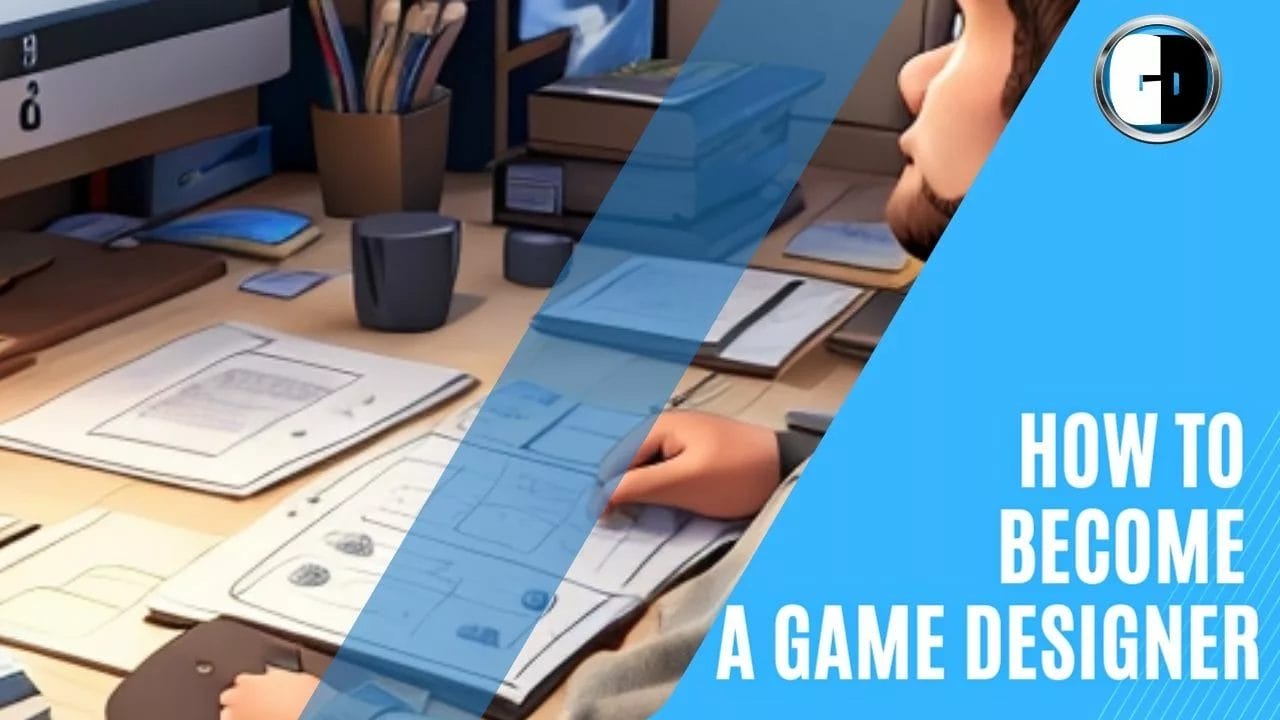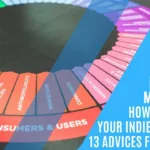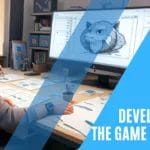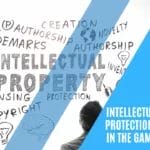If there’s one question I get asked more than anything else, it’s this: How to become a game designer? Fortunately, We have some of the answers and the ability to ask other people in our circles of industry colleagues that have helped us draft an answer to this question.
How to become a GAME DESIGNER Table of Contents
Let’s begin by addressing the most crucial questions of all: What exactly is a game designer? What are the responsibilities and duties of a game designer? And, finally, why should one contemplate embarking on the path of becoming a game designer?
What is a game designer?
The game designer is the person who designs the creative aspects of the game, such as the plot and story, levels and environment, and character interaction. They work with other professionals, such as developers and artists, to communicate ideas and manage the project through to game production.
Depending on the situation, game designers may specialize in certain game elements and work with other teams at commercial or independent game development companies.
Alternatively, they can invent, produce, program and publish titles themselves.
There is a lot of mis conceptualizations about game design and especially about the figure and role of the game designer. Most of people, when thinking about game designers, usually think about the game designer figure and fame, like for instance Kojima.

The truth is that a game designer role is much closer to one accountant than to someone purely creative, as the game designer has to control all the main mechanics of the game which will be mainly mathematics based.
While there are certainly creative elements tied to both the storytelling and visuals, it’s important to recognize that other roles involved in game creation will likely play a more influential role in the overall process.
The evolution of game design
The term “game designer” is quite common these days. Many commercial game development companies are made up of large teams with many individuals contributing to the success of the game. These include programmers, producers, level designers, modelers, animators, technical artists, testers, marketing and finance specialists and many others.
For example, level design is the concept of players brainstorming what they will encounter during the game. Course designers therefore need to consider a number of factors to create a game that is attractive to players.
Course designers do not want to create games that are too easy or too difficult. In other words, they want to create games that are “just right”, i.e. fun! To do this, the game should encourage repeated play and “Yes!” “Yes!” feeling. The game must be challenging enough to encourage repeated play and “I did it!” “I did it!” feeling.
The balance of difficulty depends on the game and the type of game. In multi-level games, the challenge progressively increases as you advance from one level to another, starting with an easy first level and gradually intensifying as you reach the next level. Alternatively, the entire campaign can be run on medium difficulty for each level.
Overview of a game
As you can see, game design is about more than just characters and plot.
Game design therefore involves many elements, not just characters and plot, but each decision is branching and requires concentration.
For example, the first decision a game designer has to make is: what kind of game do I want to make? There are many types of games: action games, sports games, puzzles, simulations, etc.
And from there, what is the theme of the game? There are many types of game software, but also many more themes. This is not difficult, and it is to illustrate the fact that no matter what ideas the game designer comes up with, there will always be people who like to play similar games.
The next step is level design, as explained above. Game designers want to create a blueprint of the level to sketch out the idea and plan how the developer will bring it to life. These blueprints can include different locations that characters can explore, such as houses, towns and dungeons.
There are many other processes involved, but this also shows how much detail is needed to design and create a game that others can enjoy.
Why consider becoming a game designer: An outlook on the Games industry

Industry trends have changed dramatically in recent years. The presence of game consoles and PCs has led to the rapid growth of independent games, casual games, social games, and mobile games, making them crucial segments within the gaming industry.
In recent years, the obstacles to game production, publishing, and digital distribution have greatly diminished. This has opened up a world of unprecedented creativity and countless opportunities to connect with a larger audience through the vast realm of the internet.
Choosing a career in game design is not only a wise decision but also a path to both stability and profitability. The impressive revenue generated by the gaming industry in the US alone, which exceeded $35 billion in 2019, serves as undeniable proof of its remarkable growth.
The bottom line is that games, whatever they are, need to be designed, coded, tested and marketed. There is room for the best talent – people with a solid and proven portfolio.
Game designer VS Game developer

There is often confusion between the terms “game design” and “game developer”. The process of game design involves the holistic creation of a game, encompassing all aspects from its conception to its realization. On the other hand, game development primarily centers around coding and may not necessarily entail the intricate design of the game itself. However, it is important to gather feedback during the coding process to make sure that the game matches the original vision.
What does a game designer actually do?
The answer is not straightforward and depends on a lot of different aspects, the size of the studio, the type of games they make, and the structure of their teams.
Game design can be a very broad or a very narrow field, depending on where you work.
On a small mobile game, for example, one designer might be responsible for every aspect of design. In larger-scale projects or even in indie games developed by small teams, game designers usually specialize in various areas, such as level design or gameplay design.

If you have a strong desire for greatness, you will discover that the team can be further divided into more specific groups, each dedicated to the design of quests and the design of the open world. Moreover, individuals with a strong focus on narrative might collaborate separately from systems designers, who specialize in developing progression systems and player rewards. You could have separate UX designers who specialize in technical aspects, economy designers who excel at crafting item drops, interface designers who focus on inventory management systems, and dialogue writers who collaborate with narrative designers to create compelling characters that players truly care about.
Game designers are responsible for designing the features that make up a game. They accomplish this by formulating innovative ideas and subsequently transforming them into tangible entities. This process involves developing detailed design documentation, comprehensive asset lists, and precise programming scripts to effectively bring their visions to life. Level designers create environments for players to explore and traverse.
Game designers provide tools to game developers, allowing them to create basic geometric shapes, known as gray boxes. These shapes are later enhanced by artists with textures and models, resulting in visually appealing game environments.
Level designers work closely with other game developers to bring game ideas to life. They collaborate with artists, animators, programmers, writers and others to create environments or missions that are both pretty and playable. They work on many aspects of games, including designing for specific encounters and tying missions together in an open world.
To be considered for most positions, it is crucial to have a certain level of experience in the gaming industry. Additionally, you must demonstrate your potential value to the studio by showcasing a strong portfolio of high-quality projects that reflect your expertise.
If there’s one piece of advice that is shared by almost everyone in the industry, is : Make stuff! Show people that you have an ability to design a game or level, and then put that together in a portfolio.

3A Pandora Box DX Arcade Console
Original Pandora Box DX Arcade Console come with the newest 3D system. While allowing users to return to the fun of childhood. Better user interface and user experience. Pause/Save/Hide/Search Games; High Score Record; Favorite List; Download 2D/3D Games; Multiplayers Game Online; Customizable Buttons; Game Classification; One Key Switch Language; Image Enhancement etc.
Showing your ability / Portfolio as a game designer/ Level designer
So if you want to be a game designer, your portfolio should include small projects like this that show your ability to come up with an interesting mechanic or system and applied it in real games ( commercial or demos). This step may be easier or harder depending on your capacity to engage with a team or with other people that are in the same situation as yours. If not, then you will have probably have to make most of the demo/showcases on your own, which depending on your skills maybe a problem or not.
If you don’t want to learn how to code games or create are for your games, and only interesting in showing your design abilities, then you could game based platforms like the PlayStation 4 game Dreams, , Roboblox, Sandbox or other platforms to create your games.
Another option is to use prebuilt assets from game stores for game engine like Unreal or Unity, where you can find not only art assets but also in some cases code snippets that you can then integrate in your game. Another option could be going through the modding path, which is taking a game that allows for the modification of assets and mechanics to modify if to match your game design.
The important thing is that you’re creating something—it doesn’t matter if it’s a vertical slice, a game jam project, or just an idea that you think might work well. Whatever the case, you need to show potential employers that you’re working hard by documenting your process so they can see your design thinking skills in action.
On their side, Level designers should create an actual level that shows off their technical proficiency with a particular toolset; for example, use Unreal or Unity to make an environment for Super Mario Bros., Portal 2, or The Legend of Zelda: Ocarina of Time or other well-known games.
It is also very important in case you are applying specifically for a company, to try to make a level that’s relevant to the company flagship game.
Whatever’s on your portfolio, make sure your stuff is finished, even if it’s relatively ¡ short. Try to focus on your best work, and always pick quality over quantity. And while downloads and documentations are great, employers can’t play and read everything so pack your portfolio with videos and screenshots.
Getting the Experience
One way to get this kind of experience is through internships, trainee positions and work experience posts. If you do well at these, there’s a chance you could be offered a full-time role at the company. Another common approach is to start in quality assurance (QA), or game testing.
This gives you experience in the industry, and a first-hand look at how studios operate. Again, it’s not uncommon for QA testers – especially those embedded in the development team – to impress their bosses and get moved into design roles at the same company.
But remember that QA is an important role on its own, and shouldn’t be seen as just a stepping stone to design. Perhaps the best advice is to remember that your first job probably won’t be designing games at Blizzard or Bungie.
You can’t be picky when you first start out, so get experience at places making mobile games, kids games or gambling games before making the leap to the studios making your favourite blockbusters.
Now there’s one pretty stellar way to get both a portfolio and experience. And that’s taking a course on game design at university. There are loads of courses for game design around the world like DigiPen in Washington, Teesside University in the UK, Breda University in the Netherlands and RMIT in Australia.
If you take these courses you’ll be taught game design theory and enough programming to get you started by people with industry experience.
A game design degree can help you make strong portfolios of work using your end-of-year projects, and it can help you meet friends and build games with them. You’ll also often get access to work experience posts and graduate positions.
But almost everyone I spoke to, including the lecturers themselves, warned that a college diploma is not a guarantee of a good job in the industry. Instead, it’s about making the most of the opportunities and connections you’re provided. And it’s about having time to really focus on building out your portfolio. It isn’t a requirement for many positions, but if you’re interested in the field, I’d urge you to consider studying game design.
Make sure you research the school carefully: look at who is teaching and their credentials and experience. Look at which studios the university has good connections with and where graduates have ended up.
Always do your research before you enrol. It’s worth mentioning that other skills and educational backgrounds can help you stand out as a candidate. For example, while coding is rarely needed as a designer, some ability to programme will help you communicate better with engineers and help you understand the scripting tools you’ll be using. Same goes for understanding other roles and pipelines like art and audio.
In addition, knowledge of relevant disciplines such as economics, architecture, art and psychology make you a better candidate when going toe to toe with those who have exclusively studied game design. And finally, we can’t discount the social side of things. The classic it’s not what you know, it’s who you know.
Making strong connections in the industry through networking events and social media can open up doors that others can’t even see. If you’ve got your CV, your portfolio and perhaps some experience under your belt; if you’ve applied for a job and got an interview; congratulations! And so—
How do you ace a design interview?
When interviewing for a design position employers are really looking for two skills:
Design thinking and interpersonal skills. The interviewer will want to know if you’re a team player who can resolve conflict and adapt to someone else’s vision. Can you communicate your ideas well? Are you resilient to feedback on your work?
Don’t be surprised if the employer dismantles your portfolio pieces to see how you’ll react to criticism of your ideas. For design thinking, the employer really wants to know if you can think about games on a deeper level than a typical fan or consumer.
You should know how games work. You should understand how changes can impact other aspects of a game. I’ve heard more than one studio ask candidates what would happen if you remove one of the options in Rock Paper Scissors to see how they’d work through the problem and show that they understand game balance.
It’s very common to be asked about the games you’ve been playing lately.
This isn’t small talk. It’s a chance for you to show some analysis, criticism, and understanding of design. For example, if you play a lot of Mario Karts., you could say something like “I found this opponent doesn’t have enough speed in the curves, or that the power ups that it is able to use are less effective in certain parts for the track. ”
If you are able to show confidence and knowledge, then you will probably nail the interview and you may be given a design test. This is where you’re asked to prove your design skills, usually on paper but perhaps in a scripting tool or level design tool.
For a game design position, you may be asked to take an existing game or two and add a new mechanic or show how you would change some part of the game.
This can be pretty stressful if it’s on-site at the studio and if it’s under a time constraint. So, here is a link to a great GDC talk about what to expect from design tests to help you prepare. Now, if you don’t get the job, that sucks—make sure you get some feedback so you can improve in the future. But if you do get the job, hooray! You’re in the industry. And so now a question to ask is: Is game design a dream job for me at this point in my life? If you follow gaming news at all, you’ll definitely have seen some headlines that might put you off working in this field for good.”
Working in game development can be exciting, but it’s not for everyone. The work can be extremely hard and stressful, as there are frequent layoffs and sometimes even studio closures. Game designers may receive threats and abuse online, and there are even stories about sexual harassment in the workplace. While strides are being made to improve these practices across the board, it’s important to do some research on a company before taking a job there, especially by looking at sites like Glassdoor and talking to former or existing employees.
Another challenge for game development is that you may not have opportunities where you live.
There are few game developers and even fewer game design courses in places like India and South America, for example. So you may need to move around to get the best jobs. But you could potentially get experience in small studios where you currently live. The thousands of indie games released every year are proof that individuals, tiny teams, and small companies can put together games without industry involvement.
But maybe you can use a different approach to become a game designer. If you want to become a game designer, start by making stuff and doing game jams. Download modding tools and practice your design thinking skills. Make friends and connections in the industry, then maybe get started with a different role or study game design at school. It’s a difficult and competitive industry to enter, but the advice in this video is general advice that should apply to most people.
How to become a game designer conclusions
The gaming industry is a rapidly growing and evolving industry, and it offers exciting and rewarding opportunities for aspiring game designers. However, the competition for jobs in the gaming industry is also fierce, so it is important for aspiring game designers to have the skills and experience necessary to stand out from the crowd.
One of the best ways to develop the skills necessary for a career in game design is to pursue formal education. There are many universities and colleges that offer degrees in game design, and these programs can provide students with the knowledge and skills they need to succeed in the industry. In addition to formal education, aspiring game designers can also gain valuable skills and experience by working on personal projects or internships.
Another important factor for aspiring game designers is to stay up-to-date with the latest software tools and technologies used in game development. The gaming industry is constantly evolving, and new tools and technologies are emerging all the time. By staying up-to-date, aspiring game designers can ensure that they have the skills and knowledge necessary to create games that are visually stunning and technically advanced.
In addition to technical skills, aspiring game designers also need to have strong creative and problem-solving skills. Game design is a creative process, and it requires the ability to come up with new and innovative ideas. Game designers also need to be able to solve problems, as they will often encounter challenges during the development process.
Networking with professionals in the gaming industry is another valuable strategy for aspiring game designers. Attending industry events, joining online communities, and participating in game jams can provide opportunities to connect with like-minded individuals, learn from experienced professionals, and showcase one’s talent and creativity.
Finally, it is important for aspiring game designers to stay abreast of industry trends. Being familiar with popular game genres, emerging technologies, and player preferences can give designers a competitive edge and help them create innovative and engaging game experiences.
In conclusion, with dedication and perseverance, aspiring game designers can turn their passion for gaming into a fulfilling profession. The gaming industry offers a vast and ever-evolving landscape where talented individuals have the chance to create immersive and captivating experiences for players worldwide. By honing their skills, networking with professionals, and staying up-to-date with industry trends, aspiring game designers can increase their chances of making a mark in the gaming industry and bringing their creative visions to life.
Here are some additional tips for aspiring game designers:
Pursue formal education
Aspiring game designers can pursue a degree in game design or related fields to hone their skills. This can provide them with a strong foundation and knowledge of design principles. There are many different universities and colleges that offer degrees in game design, so aspiring game designers can choose a program that best suits their needs and interests.
Some of the benefits of pursuing formal education in game design include:
- Gaining a strong foundation in the principles of game design
- Learning from experienced professionals
- Networking with other aspiring game designers
- Gaining access to industry-standard software and tools
Gain practical experience
In addition to formal education, aspiring game designers can gain practical experience through internships or personal projects. This can help them build a portfolio and showcase their talent and creativity. Internships are a great way to gain experience working on real-world game development projects. They can also provide aspiring game designers with the opportunity to network with professionals in the industry.
Personal projects are another great way to gain practical experience. Aspiring game designers can create their own games, or they can contribute to open-source game projects. Personal projects can help aspiring game designers to develop their skills and to learn new technologies.
Stay updated with the latest software tools and technologies
The gaming industry is constantly evolving, so it is important for aspiring game designers to stay updated with the latest software tools and technologies used in game development. This can help them to create games that are visually stunning and technically advanced. There are many different resources available to help aspiring game designers stay up-to-date, such as online tutorials, industry publications, and conferences.
Network with professionals
Networking with professionals in the gaming industry can provide opportunities to connect with like-minded individuals, learn from experienced professionals, and showcase one’s talent and creativity. There are many different ways to network with professionals in the gaming industry, such as attending industry events, joining online communities, and participating in game jams.
Stay abreast of industry trends
Being familiar with popular game genres, emerging technologies, and player preferences can give designers a competitive edge and help them create innovative and engaging game experiences. Aspiring game designers can stay abreast of industry trends by reading industry publications, attending industry events, and following gaming influencers on social media.
In conclusion, becoming a game designer is a challenging but rewarding career path for those who love games. Aspiring game designers can increase their chances of success by pursuing formal education, gaining practical experience, staying updated with the latest software tools and technologies, networking with professionals, and staying abreast of industry trends.
Here are some additional tips for aspiring game designers:
- Play a variety of games. The more games you play, the better you will understand what makes a game fun and engaging.
- Read books and articles about game design. There is a wealth of information available about game design, and reading about the latest trends and techniques can help you stay ahead of the curve.
- Start small. Don’t try to create the next big hit right away. Start by creating small, simple games that you can finish in a few weeks or months.
- Get feedback from others. Once you have created a game, get feedback from friends, family, and other gamers. This feedback can help you identify areas where your game can be improved.
- Don’t give up. The gaming industry is competitive, but if you are passionate about game design and you are willing to put in the hard work, you can achieve your dreams.
You can find more valuable articles on our blog.







